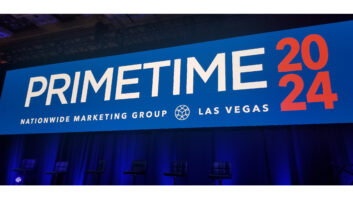CBS CEO Les Moonves took to the stage at International CES, held here earlier this month, to demonstrate that there is no longer a distinction between old and new media.
“We’re all playing on the same big digital field,” Moonves said of supposedly traditional media like his broadcast-television business and upstart ventures putting video and other content on the Web.
To show that CBS was in the game, he shared the stage with some of the biggest names in online entrepreneurship, including the founders of YouTube.com, the market-defining video-sharing site that had barely launched when the 39th CES was staged, and Sling Media, the company that pioneered the idea of “slinging” shows from a home TV on the Internet to a computer wherever one happens to be.
Without digging into the potential copyright reuse issues, Sling founder Blake Krikorian introduced a Clip+Sling service that would allow television viewers to easily identify the starting and ending points of parts of shows they have watched, clip them using on-screen scissors and e-mail the clips, along with comments, to friends.
The service was demonstrated with a clip from CBS show “Two and a Half Men,” with Moonves assuring the audience that the clipping service would respect the rights of content creators. Among the benefits: The e-mail that appears in the recipient’s mailbox prompts the user to buy a full episode or subscribe to future shows.
After Krikorian came Chad Hurley, whom no one at this show a year ago considered a factor in the re-emergent field of online video. He sold his company in midyear for $1.7 billion to Google, whose founder delivered a keynote here 12 months ago to tout an online video store that generated little subsequent buzz.
Hurley’s message — iterated by Moonves — was that the CBS channel on YouTube was itself a success, with 75 million viewings of its content since launch in November.
And CBS is clearly trying to recognize that it understands the short-form video of YouTube, using it to allow viewers anywhere to achieve their 15 seconds of fame.
Hurley and Moonves showed off a contest on YouTube where CBS’ audience is encouraged to file videos of their own making that last no longer than 15 seconds and send the world a message of their choice. The reward: The best video will be presented on the Super Bowl telecast next month, which is being shown on CBS stations.
This is “changing the nature of viewing television,” Hurley said. Online sites, he added, are being used to bring viewers back to conventional television watching.
Moonves was bent on showing that CBS also can dance digitally on its own, with homegrown innovation in interactive content.
Among the examples:
- Paltalk.com, where listeners of the Opie & Anthony talk show on CBS radio stations install Web cams in their homes and interact during radiocasts with the hosts, even if they happen to be doing housework or wearing next to nothing.
- Ourchart.com, where fans of “The L Word” on CBS’ Showtime pay television network can make connections with each other. The device: user profiles that visually show their links to other users. Click on one and that person becomes the center of a new web of straight lines that lead to other users, ad infinitum, in theory. In an example of life imitating art, the idea first surfaced on an episode of the show.
- Fans Only: watching a shootout between Duke University and Georgetown University while you’re relaxing at home? Bring on friends in your video buddy list and watch the game along with them. They’ll appear on your screen along with the game, and you can chat — and worse — from your seat as if you were in the arena together. You can choose the camera angle you want on a disputed call as well — sports watching on steroids, if you will. Moonves called it “a virtual sports bar for college fans … and you don’t have to worry about being carded.”
Along the way, Moonves demonstrated his familiarity with the lingo and environs of digital content, making it clear that he knew about the “Numa Numa dance” and the effects of Mentos when inserted into soda bottles. Professional content, he said, could play on that field, not just YouTube.
“In the blink of an eye, anything’s possible,” added Moonves, who also appeared at last year’s CES in the Google-Page keynote, touting the delivery of CBS shows through the Google Video Store. That was when CBS first broke off from Viacom.
In the year that passed, CBS’ stock price increased 25 percent, while his counterpart at what remained of Viacom — Tom Freston — was fired by the man, Sumner Redstone, who ran both shows.
Freston, by some accounts, lost his job at the company that runs the youth-oriented MTV Networks for not pursuing an acquisition of YouTube aggressively enough.













